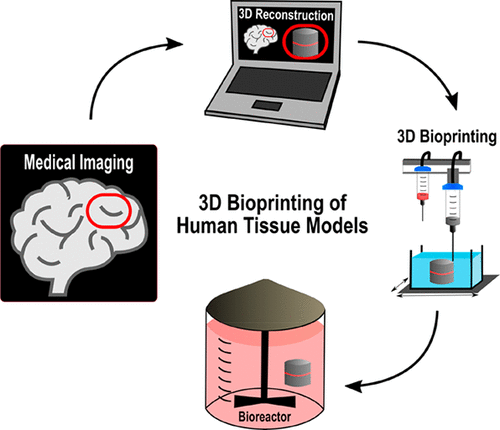当前位置:
X-MOL 学术
›
Chem. Rev.
›
论文详情
Our official English website, www.x-mol.net, welcomes your feedback! (Note: you will need to create a separate account there.)
Emulating Human Tissues and Organs: A Bioprinting Perspective Toward Personalized Medicine.
Chemical Reviews ( IF 62.1 ) Pub Date : 2020-09-16 , DOI: 10.1021/acs.chemrev.0c00342 Ana Clotilde Fonseca 1 , Ferry P W Melchels 2 , Miguel J S Ferreira 3 , Samuel R Moxon 4 , Geoffrey Potjewyd 4 , Tim R Dargaville 5 , Susan J Kimber 6 , Marco Domingos 3
Chemical Reviews ( IF 62.1 ) Pub Date : 2020-09-16 , DOI: 10.1021/acs.chemrev.0c00342 Ana Clotilde Fonseca 1 , Ferry P W Melchels 2 , Miguel J S Ferreira 3 , Samuel R Moxon 4 , Geoffrey Potjewyd 4 , Tim R Dargaville 5 , Susan J Kimber 6 , Marco Domingos 3
Affiliation

|
The lack of in vitro tissue and organ models capable of mimicking human physiology severely hinders the development and clinical translation of therapies and drugs with higher in vivo efficacy. Bioprinting allow us to fill this gap and generate 3D tissue analogues with complex functional and structural organization through the precise spatial positioning of multiple materials and cells. In this review, we report the latest developments in terms of bioprinting technologies for the manufacturing of cellular constructs with particular emphasis on material extrusion, jetting, and vat photopolymerization. We then describe the different base polymers employed in the formulation of bioinks for bioprinting and examine the strategies used to tailor their properties according to both processability and tissue maturation requirements. By relating function to organization in human development, we examine the potential of pluripotent stem cells in the context of bioprinting toward a new generation of tissue models for personalized medicine. We also highlight the most relevant attempts to engineer artificial models for the study of human organogenesis, disease, and drug screening. Finally, we discuss the most pressing challenges, opportunities, and future prospects in the field of bioprinting for tissue engineering (TE) and regenerative medicine (RM).
中文翻译:

模拟人体组织和器官:个性化医疗的生物打印视角。
缺乏能够模拟人体生理的体外组织和器官模型严重阻碍了具有更高体内功效的疗法和药物的开发和临床转化。生物打印使我们能够通过多种材料和细胞的精确空间定位来填补这一空白,并生成具有复杂功能和结构组织的 3D 组织类似物。在这篇综述中,我们报告了用于制造细胞结构的生物打印技术的最新发展,特别强调了材料挤出、喷射和大桶光聚合。然后,我们描述了用于生物打印的生物墨水配方中使用的不同基础聚合物,并检查了用于根据可加工性和组织成熟度要求定制其性能的策略。通过将功能与人类发展中的组织联系起来,我们研究了多能干细胞在生物打印背景下对新一代个性化医疗组织模型的潜力。我们还强调了设计用于研究人体器官发生、疾病和药物筛选的人工模型的最相关尝试。最后,我们讨论了组织工程 (TE) 和再生医学 (RM) 生物打印领域最紧迫的挑战、机遇和未来前景。
更新日期:2020-10-15
中文翻译:

模拟人体组织和器官:个性化医疗的生物打印视角。
缺乏能够模拟人体生理的体外组织和器官模型严重阻碍了具有更高体内功效的疗法和药物的开发和临床转化。生物打印使我们能够通过多种材料和细胞的精确空间定位来填补这一空白,并生成具有复杂功能和结构组织的 3D 组织类似物。在这篇综述中,我们报告了用于制造细胞结构的生物打印技术的最新发展,特别强调了材料挤出、喷射和大桶光聚合。然后,我们描述了用于生物打印的生物墨水配方中使用的不同基础聚合物,并检查了用于根据可加工性和组织成熟度要求定制其性能的策略。通过将功能与人类发展中的组织联系起来,我们研究了多能干细胞在生物打印背景下对新一代个性化医疗组织模型的潜力。我们还强调了设计用于研究人体器官发生、疾病和药物筛选的人工模型的最相关尝试。最后,我们讨论了组织工程 (TE) 和再生医学 (RM) 生物打印领域最紧迫的挑战、机遇和未来前景。



























 京公网安备 11010802027423号
京公网安备 11010802027423号